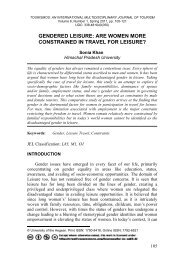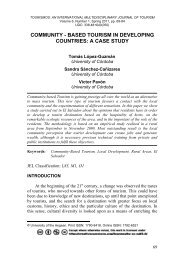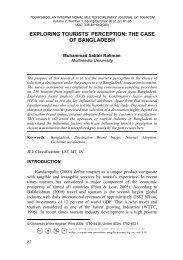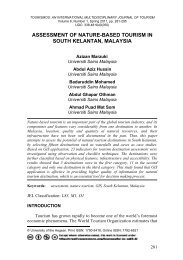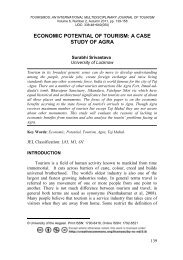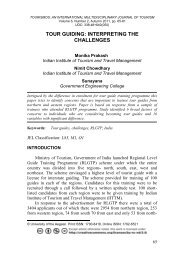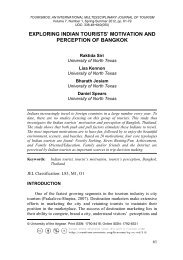TOURISMOS is an international, multi-disciplinary, refereed (peer ...
TOURISMOS is an international, multi-disciplinary, refereed (peer ...
TOURISMOS is an international, multi-disciplinary, refereed (peer ...
Create successful ePaper yourself
Turn your PDF publications into a flip-book with our unique Google optimized e-Paper software.
A. Akın Aksu & Sevc<strong>an</strong> Yildiz<br />
Generally speaking, training enables people to adopt ch<strong>an</strong>ge in their<br />
behaviour in-line with the establ<strong>is</strong>hment’s targets (i.e., Cengizh<strong>an</strong> <strong>an</strong>d<br />
Ersun, 2000: 731). Other definitions suggest that training helps people to<br />
successfully communicate with their environment (Binbaşıoğlu, 1995).<br />
From <strong>an</strong> org<strong>an</strong>izations’ perspective, training compr<strong>is</strong>es all m<strong>an</strong>agement<br />
targets that aim to increase commercial success in terms of effectiveness<br />
<strong>an</strong>d productivity (Yüksel, 2000).<br />
Training has <strong>an</strong> import<strong>an</strong>t place in hum<strong>an</strong> resource applications.<br />
Today, it <strong>is</strong> well-recognized that hum<strong>an</strong>s <strong>an</strong>d information are both vital in<br />
terms of power <strong>an</strong>d capital of communities. Beside recruitment <strong>an</strong>d testing<br />
of new personnel, training continues in commercial import<strong>an</strong>ce (Fındıkçı,<br />
2000).<br />
With the current competition among establ<strong>is</strong>hments, improving<br />
knowledge levels <strong>an</strong>d skills of personnel, especially at the point of<br />
production, are vital (Yilmaz & Gunel, 2009). Ch<strong>an</strong>ges in production<br />
equipment <strong>an</strong>d methods, force establ<strong>is</strong>hments to develop different training<br />
programs (Mucuk, 2001).<br />
However, training programs are expensive for establ<strong>is</strong>hments.<br />
Therefore, they have to pl<strong>an</strong> a suitable budget <strong>an</strong>d fin<strong>an</strong>cial resources for<br />
training. The ASTD report (2002), identified that more th<strong>an</strong> 350<br />
establ<strong>is</strong>hment are allocating between 1 per cent <strong>an</strong>d 3 per cent of their<br />
budgets for training. As a result they have generated profits of more th<strong>an</strong><br />
$1400 per person; with average training costs per person of $700<br />
(www.learningcircuits.org:reachingdate: 27.09.2005).<br />
In pl<strong>an</strong>ning for training, all individuals must work together in order to<br />
identify training targets. As a result, funding for training will be successful<br />
(i.e., Baltaş, 2000: 1). Generally, it will be better to define training needs of<br />
individuals before training. To justify the cost of training, comparing the<br />
new-found skill-levels of individuals’ <strong>is</strong> suggested (Sabuncuoğlu, 2000).<br />
In order to gain the highest productivity from training, there are four<br />
import<strong>an</strong>t factors:<br />
1. The support of m<strong>an</strong>agement<br />
2. Adequency of the instructor<br />
3. Cooperation of hum<strong>an</strong> resources <strong>an</strong>d training departments<br />
4. Dem<strong>an</strong>d <strong>an</strong>d readiness levels of individuals undertaking<br />
training.<br />
Hum<strong>an</strong> resource <strong>an</strong>d training departments must org<strong>an</strong>ize, <strong>an</strong>nounce<br />
<strong>an</strong>d evaluate training processes. Additionally, they have to attract<br />
individuals for training (www.baltas-baltas.com:reachingdate:<br />
22.09.2005). Normally, training must affect individuals in a positive way.<br />
194



